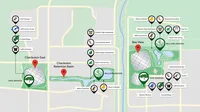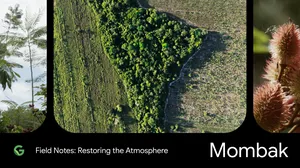How we’re restoring native habitats in Silicon Valley

Vast oak woodlands punctuated with lush willow groves once stretched from Palo Alto to San Jose and beyond, long before the rise of Silicon Valley.
“Centuries of agricultural intensification and urbanization have transformed these landscapes,” says Erin Beller, Google’s ecology program lead who studied Silicon Valley’s ecological history and restoration potential for her PhD. “We’ve lost over 99% of these valuable native habitats.”
Now, Google’s real estate and ecology teams are working to bring nature back into the built environment — in part, by restoring critical habitats like oak woodlands and willow groves across our Bay Area campuses. The goal is to revive the area’s ecological heritage and bolster the human experience while creating thriving, functional landscapes for a biodiverse constellation of species.
Already, the team has restored over 15 acres on Google’s campuses and in the surrounding urban landscape, in partnership with local NGOs, ecology experts and government agencies. This work includes everything from creating welcoming habitat patches for pollinators like native bees and monarch butterflies to partnering on larger projects like restoring the Charleston Retention Basin.
A monarch butterfly on narrow-leaf milkweed on Google’s Sunnyvale campus. We’ve committed $1 million to help California’s monarch butterfly conservation efforts, adding more habitat on our campuses and supporting the creation of 600 acres of habitat across the state.
A great egret standing in its nest at the Shorebird Way rookery, the largest in the South Bay area. Google protects the rookery by closing the road to vehicles during nesting season each year. Hundreds of snowy egrets, great egrets and black-crowned night herons return annually to nest and raise their young.
Two members of the ecology team walk along a path between native plants in the South Bay campus. Google’s real estate and ecology teams are working to bring nature back into the built environment.
Together these efforts drive landscape-scale restoration of historical ecosystems like oak woodlands, willow groves, meadows and grasslands, and creek and wetland habitats. Oaks and willows are especially important to Beller’s team because they play a defining role in sustaining ecosystems. Both support a dizzying array of wildlife and have great potential to adapt to California’s changing climate. “Oaks and willows have superpowers,” says Beller.
Oak canopies: host to a community of creatures
Iconic trees of the California landscape, oaks once dominated Silicon Valley. Oaks are drought-tolerant, fire-resistant, and efficient at removing air pollution and absorbing carbon from the atmosphere.
Oak woodland ecosystems sustain some of the highest plant and animal diversity in California, supporting 2,000 additional plant species and around 5,000 insect species. Hundreds more birds, mammals and other wildlife rely on the richness of oak woodlands for food, shade and shelter.
A juvenile bushtit pictured at the Charleston Retention Basin. Insectivorous birds, like the bushtit and oak titmouse, feed on insects they find in oaks. These smaller birds are prey for predators like raptors and northern pygmy owls.
A Western bluebird perched beside an oak tree at Google’s Bay View campus.
A cynipid wasp gall on an oak by the Charleston Retention Basin. More than 130 species of cynipid wasps depend on Silicon Valley’s oaks to build their galls. Galls are an overgrowth of plant tissue produced in response to chemicals secreted by wasp larvae. Most wasp galls cause little or no lasting damage to oaks, and the insects that cause them help form complex food webs that are partially responsible for the amazing biodiversity found in oak habitats.
Young oaks and native understory planting at Charleston East. In the next decade, Google estimates that the diverse network of oak species at Charleston East will provide 80,000 square feet of connected tree canopy.
Oak leaves and acorns are consumed by herbivores like red and eastern gray squirrels (pictured) and birds like the California scrub jay, which consumes and disperses acorns, helping the trees to propagate.
Oaks can bring powerful benefits to urban areas, like creating wildlife corridors and mitigating the urban heat island effect. Already, Google has planted hundreds of oak trees across our Mountain View and Sunnyvale campuses, with plans to plant hundreds more. These efforts follow guidelines for tree density and spacing laid out in "Re-Oaking Silicon Valley," a study Beller co-authored with her extended team that also serves as a resource for other businesses and organizations.
Wetland willows: a stop for migratory birds
Whereas oaks thrive on well-drained valley soils, willows flourish in low-lying areas where groundwater is close to the surface. Because willows tap this groundwater, they stay lush and green well into the dry season, reducing the need for irrigation.
Like oaks, willows sequester carbon once mature. They’re also critical for insect biodiversity and can provide high-quality food for insectivorous birds and other wildlife. Silicon Valley has lost nearly all of its willow groves, which once served as essential stopovers for migratory birds heading south.
The Google Bay View campus incorporates stormwater retention basins designed to support willows, so the trees can provide habitat for migratory bird species and longer-term residents like pollinators, lizards, songbirds and other small animals. (Iwan Baan for Google)
Songbirds like willow flycatchers (pictured) and Wilson’s warblers rest and refuel among the valley’s willows. They spend several days gorging on huge quantities of insects before continuing on their long journey to Central America.
Google’s field researchers in the shade of a willow grove at the Charleston Retention Basin, a partnership between Google, the City of Mountain View, HCP Life Science and LinkedIn. Google removed more than 100 parking spaces to help create more extensive willow floodplains, cottonwood groves and other habitats here.
Thanks to Google’s willow grove restoration initiatives like those around the Charleston Retention Basin and on our Bayview and Charleston East campuses, there are more places for migratory songbirds to rest and find food to replenish their energy en route.
At the Charleston Retention Basin — home to one of the largest willow groves in the region — there are new trails, seats and lookout points so people can immerse themselves in the outdoors and appreciate the biodiversity around them.
Bringing nature back beyond the Bay
In addition to projects in the Bay Area, Google’s ecology team has urban greening projects in the works across several of our campuses, including in the heart of London, Munich and New York.
“Nature and people should be able to flourish together in the campuses and communities that Google calls home,” says Beller.
This work is part of a bigger global movement. The idea that nature in cities is crucial for both people and wildlife is taking root, and high-profile projects like London’s National Park City to The High Line of New York have brought it into the public consciousness.
“We know that access to nature has profound benefits for human health and wellbeing,” says Kate Turpin, director of design performance for Google’s real estate development team. “It can be a place of refuge, from a hot day or the busy pace of working life.”
A field researcher measures the height of native narrow-leaf milkweed on the Google campus, as part of biodiversity monitoring efforts.

To help scale their ideas, Beller’s team supports open-source scientific research, from local guidelines for native planting in Silicon Valley for institutions and residents to academic research about the value of urban nature. “From backyards to businesses, we hope everyone will pitch in to bring nature back into cities,” says Beller. They have also partnered with local scientists to monitor these new habitats on campus, using data to measure the impact of native landscaping on bird and insect biodiversity and inform future campus restoration efforts.
The early signs in the Bay Area are promising. “I can step out of the office and lose myself among the willow groves around the Charleston Retention Basin — enjoy a walk in the shade, spot birds and butterflies, and hear the hum of a functioning ecosystem all around me,” says Beller. “I’ve spent a large part of my career as an ecologist reflecting on what was. It’s awe-inspiring to think about what could be.”







